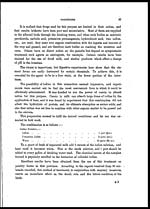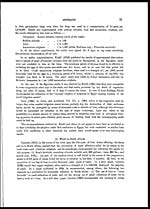Medicine - Veterinary > Veterinary colleges and laboratories > Indian journal of veterinary science and animal husbandry > Volume 1, 1931 > Part I (March 1931) > Abstracts
(84) Page 50
Download files
Individual page:
Thumbnail gallery: Grid view | List view

ABSTRACTS
Large-scale Treatment of Lands infested with Parasites.
(For the purpose of this note, the term " Treatment" has been taken to include, in addition to
dressing of lands, such operations as drainage, desiccation, clearing of bushes and rotation
of crops and grazing animals.)
The bulk of the work carried out under this head has been directed to the destruction of the
different species of snails known or suspected to be the intermediate hosts of certain trematodes
known to be pathogenic to man and animals. Some work has also been done upon the ridding of
pastures of certain common species of nematodes, e.g., the stomach worms of sheep (Hœmonchus
contortus and Ostertagia spp.), but investigations in this connection have not been pursued very
far. No work appears to have been done in regard to the control of the cestodes of ruminants,
presumably because the life-history of these parasites is not yet known.
A. MEASURES AGAINST TREMATODES.
Egypt, South Africa and Wales would appear to be the only localities where more or less
intensive investigations have been conducted upon the problem of controlling the molluscan hosts of
trematodes known to be pathogenic to man and animals. The results of these investigations
may be briefly summarized as follows :—
(a) Work in Egypt.
Work in Egypt has been conducted mainly with reference to the control of Bilharziasis, these
investigations having been inaugurated by Leiper as early as in the year 1915 and later continued
by Khalil, who has since published a full account of the work in the Reports and Notes of the
Public Health Laboratories, Cairo, (1924). The following is an abstract of the information
contained in the Reports :—
Leiper (1915-18) observed that snails were incapable of resisting desiccation for more than
a short period and that a weak solution of ammonium sulphate (commonly used as a fertilizer)
killed the molluscan hosts of Bilharzia (Schistosoma) within a few hours. He therefore proposed
a combination of the two methods in attacking the snails. Two years later, Khalil and Lee found
that the snails were killed in 1 in 1,000,000 copper sulphate solution in tap water after 5½ hours'
immersion. During the next few years, Khalil conducted what would appear to be an extensive series of
experiments upon the destructive power of this chemical for snails and the result obtained by him
led him to formulate the following recommendation for adoption in the field : " If copper sulphate
solution is to be utilized in combating Bilharziasis in Egypt, it will have to be put into small
irrigation channels and drains choked with vegetation and algæ and hence a concentration of 1 in
300,000 to 1 in 200,000 will be the lowest practicable one, if the laboratory results were to be
found applicable to the conditions in the field." The drug, when used in the above concentration,
is stated by him to be harmless for man and higher animals, although its effect on fish " is
doubtful", whilst it was found by him to exert no deleterious effect upon cotton, maize and wheat
( 50 )
Set display mode to: Large image | Zoom image | Transcription
Images and transcriptions on this page, including medium image downloads, may be used under the Creative Commons Attribution 4.0 International Licence unless otherwise stated. ![]()
| Permanent URL | https://digital.nls.uk/75226046 |
|---|
| Description | Covers articles from 1931. |
|---|




